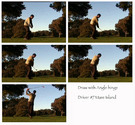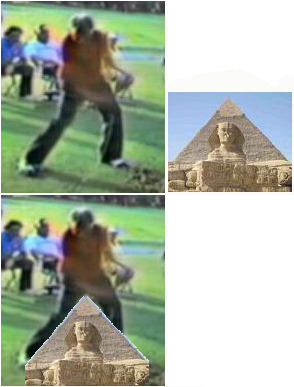Great observations there Arnie,
Obviously you have really been working on some of these concepts.
One of the great advantages of less plane shifting, flatter backswing, or the higher hand position at address (Moe Norman – shoulder plane) is that you don’t have to worry “as much” about getting back down to elbow plane.
Sam Snead always talked about “soft hands” but it is important to understand that soft hands don’t always mean light grip.. Hogan’s soft looking hands at the transition are often mistaken for noodle arms.. don’t be fooled… I am quite convinced that this is the reason Hogan was a ball beater, because ball beating does tend to soften the hands… (I can relate, because I was a ball beater, now I just use the bag instead)
You can train the wrists to be free, flexible, and oily, and still maintain a very firm grip on the club. It can take some time, but it can be done.
This soft hands (really wrists) you can see active in the transitions at the top of the backswing of many great players. It is most clearly evident when watching the players who we can visually see the layoff of the shaft at the transition. The transition is greatly effected by the path of the backswing, and the tempo.
Let’s look at Trevino, we see a strong out to in action, all set up with great intentions. He uses the backswing to throw the club down into the slot with an out to in action. He limits the plane shifting with a short backswing. All this really so he can keep a firmness in the arms and hands, and maintain a constant grip pressure and tension.
Your feeling of wanting to have lighter grip pressure or lighter tension to get into the slot is typical of swingers.
The gravity drop into the slot is one way to do it.. The upright swings that make the big drop down requires slower tempos, and either a learned patience or a natural, “just kinda of have it”.
If this is something that you just can’t seem to do, or constantly fight,
then the flat backswing could be a viable option. The key to the flat swing is to learn the real dynamic pivot actions that are required to do so. All the talk about loading the feet, and clearing the hips quickly post impact, all that great stuff is without doubt the best way to hit a golf ball. Why? This is what the greats do..
Hitters who rely on body rotation, particularly an increase in post impact rotational speed, can really benefit from a flat or level shoulder turn more than swingers. If you turn flat, as in this case,
you have to straighten the right arm on the downswing, and it is this active straightening of the right arm from P2 to _P3 that is what I believe a lot of TGM hitters experience as right arm thrust…
To get the feeling right, I drill the transition only, then the post impact feeling of the right arm..
I consider it a mortal sin to drill from P2 to P3 anything.. because it encourages quiting… nothing makes me cringe more than the players who rock back and forth from the the top to p3 and back..
or back and forth.. you NEVER want to train the body, arms or hands to STOP on the way down to the ball… NEVER.
So Arnie,
I suggest keeping the same firmness you are experiencing during the “orbit pull out” throughout the swing.. and experiment with how you can make the transition from backswing to downswing keeping these tensions in place. Flattening the backswing and activating right arm straightening on the downswing should go a long way toward getting you to where you want to be.. not only regarding plane shifting, but keeping the firmness and tension you are realizing needs to be preserved.
Is the Hale swing leaving us? LOL
The reason I prefer to teach and play from a more traditional set up position with the hands closer and lower to the body at address and impact is that it encourages body activity. If you put your hands high at address, and stand farther from the ball, there is a tendency to start the club back with just the arms and not the body. Golfers love to swing with their arms and not their bodies.
The standing close to the ball, hands low really encourages the golfer to engage the body. (Mac O). Mac is a master of this move and he is the king of right arm straightening via flat shoulders on the downswing to enable the effectiveness of such radical plane shifting.
Getting back to Moe, I don’t think Moe’s “one plane” swing should be taught until a student has shown the ability to maximize torso rotation while employing minimal hand travel….and really has this down.. it’s very advanced ball striking stuff. Anyone working on Moe’s move really has to understand this.. Moe is a real unique study… but it’s not as simple as it looks obviously. The “one plane” concept sounds simple but it takes a very effective pivot action to make it work properly, which Moe had. It can be learned though.
Lag Pressure throwaway is the root of all golf’s evils
































